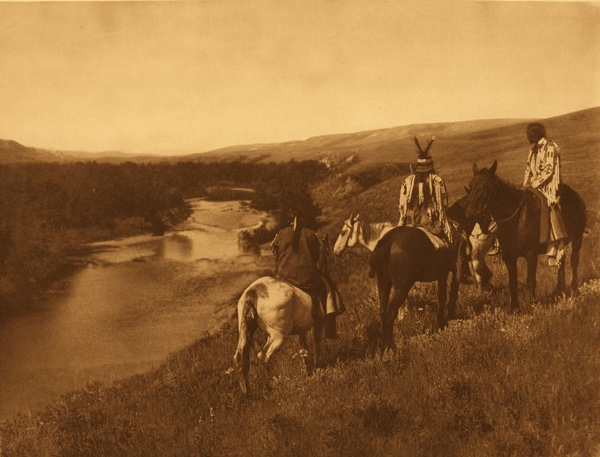A Kidnapping[1]Originally aired weekdays by Yellowstone Public Radio during the Bicentennial observance of 2003-2006. Narrated by Hal Hansen. Scripts by Whit Hansen and Ed Jacobson. Produced by Leni Holliman. © … Continue reading
by Yellowstone Public Radio[2]Originally aired weekdays by Yellowstone Public Radio during the Bicentennial observance of 2003-2006. Narrated by Hal Hansen. Scripts by Whit Hansen and Ed Jacobson. Produced by Leni Holliman. © … Continue reading
Piegans
Edward S. Curtis (1868–1952)
Northwestern University Library, Edward S. Curtis’s “The North American Indian,” 2003, http://curtis.library.northwestern.edu/site_curtis.
The caption provided by Curtis for the above photo:
This scene on Two Medicine river near the eastern foothills of the Rocky Mountains is typical of the western portion of the Piegan country, where the undulating upland prairies become rougher and more broken, and finally give place abruptly to mountains.”[3]Edward S. Curtis, The North American Indian (1907-1930) v.06, The Piegan. The Cheyenne. The Arapaho (Cambridge, Mass.: The University Press, 1911), plate no. 184.
Smithing for Buffalo Meat
Some cloudy & cold. a nomber of the Savages continue bringing corn and fat dryed buffaloe meat for to Git Blacksmiths work done.
—John Ordway
The Rocky Mountain Indians
visited by the Greesey head & a Riarca to day, those men gave Some account of the Indians near the rockey mountains
—William Clark
A Stolen Daughter
a young Indian same nation & Different Village Stole the Doughter of the Black man, he went to his Village took his horse & returned & took away his doughter
—William Clark
Weather Diary
State of Ther. at rise
Weather wind at rise
State of Thermt. at 4 OClock Weather at 4 Ock Wind at 4 OClock State of the River 7 [above 0] clear E 12 [above 0] fair E rise 2½ in. —Meriwether Lewis[4]To assist the reader, the editor of this web page has omitted the “Day of Month 1805” column and spelled out some abbreviations.
Experience the Lewis and Clark Trail
The Lewis and Clark Trail Experience—our sister site at lewisandclark.travel—connects the world to people and places on the Lewis and Clark Trail.
Plan a trip related to March 8, 1805:

Fort Mandan is a High Potential Historic Site along the Lewis and Clark National Historic Trail managed by the U.S. National Park Service. The North Dakota Department of Parks and Recreation manages a modern reconstruction and the Lewis and Clark Interpretive Center located at US Hwy 83 and ND Hwy 200A.
Knife River Indian Villages National Historic Site is a High Potential Historic Site along the Lewis and Clark National Historic Trail managed by the U.S. National Park Service. A unit of the National Park System, the site is located at 564 County Road 37, one-half mile north of Stanton, North Dakota. It has exhibits, trails, and a visitor center.
Notes
| ↑1 | Originally aired weekdays by Yellowstone Public Radio during the Bicentennial observance of 2003-2006. Narrated by Hal Hansen. Scripts by Whit Hansen and Ed Jacobson. Produced by Leni Holliman. © 2003 by Yellowstone Public Radio. |
|---|---|
| ↑2 | Originally aired weekdays by Yellowstone Public Radio during the Bicentennial observance of 2003-2006. Narrated by Hal Hansen. Scripts by Whit Hansen and Ed Jacobson. Produced by Leni Holliman. © 2003 by Yellowstone Public Radio. |
| ↑3 | Edward S. Curtis, The North American Indian (1907-1930) v.06, The Piegan. The Cheyenne. The Arapaho (Cambridge, Mass.: The University Press, 1911), plate no. 184. |
| ↑4 | To assist the reader, the editor of this web page has omitted the “Day of Month 1805” column and spelled out some abbreviations. |



